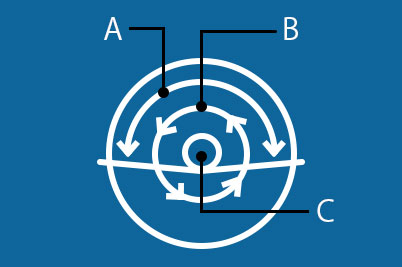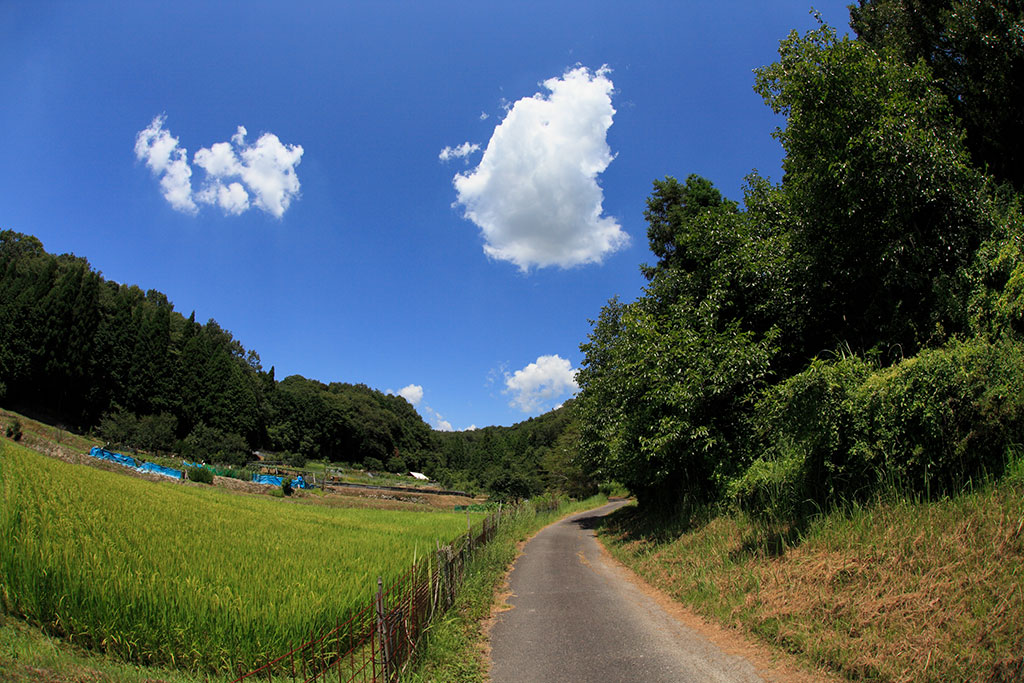Professional Composition Techniques (4): Using Special Lenses
Other than wide-angle, standard, and telephoto lenses, there are also special lenses such as macro and fisheye lenses. These lenses provide special angles-of-view, giving you a new perspective on the world around you. Find out how you can use them to enhance your compositions. (Written by: Tatsuya Tanaka)

Macro lenses
Macro lenses are a special type of lens that allows you to photograph small subjects close-up. They can be used to photograph various things, such as insects, plants, or even food.
A “true macro lens” has a reproduction ratio of at least 1:1 (1.0x magnification), which means that at the closest focusing distance, the final image of the subject is life size. This makes them good for filling the frame with your subject or drawing attention to fine details.
The macro lens angle-of-view at 1.0x magnification

A: Angle-of-view
B: Area that is magnified by 1.0x
C: Lens
At 1.0x magnification, the angle-of-view becomes extremely narrow, resembling that of a super telephoto lens.
Learn more about macro lenses in: Uncover a Whole New World with Macro Lenses
Use a macro lens to close in on insects and flowers
A macro lens allows you to photograph insects and flowers from closer-up than usual.
Tip: For sensitive subjects, use a 180mm telephoto macro lens. You will be able to achieve the 1.0x magnification without having to go too close to the subject, as compared to a shorter lens.


This shot of a butterfly approaching a flower was taken with a 180mm telephoto macro lens. I have also used the Rule-of-Thirds composition.
Use a macro lens to magnify details on subjects
You can use macro lenses to close in on details that we might not usually notice, such as the lines and veins on this leaf.


This close-up of the veins on a fallen leaf was shot with a 100mm macro lens. I organised the composition along the diagonal line.
Know this (1): Macro shots are prone to camera shake
When you shoot close-up, your lens might cast a shadow over the subject, resulting in insufficient lighting. As the depth-of-field is usually already very shallow, using a wider aperture is probably not a viable option. You will have to either light up the subject, or use a slower shutter speed. The latter increases the risk of camera shake, which becomes more obvious the higher the magnification. It helps if your lens has built-in image stabilisation (IS). You can also use a tripod for better stability.
Also see: Macro Photography in Low Light: Preventing Camera Shake
Know this (2): The most efficient way to use manual focus
It is often easier to use manual focus (MF) for macro photography because the small depth-of-field makes AF challenging. In a normal shot, you would probably compose your photo first and then turn the focusing ring to make the image sharper. But in macro photography, turning the focusing ring also changes the magnification ratio, which in turn changes the composition.
Here’s a more efficient way:
1. Turn the focusing ring until you get the magnification ratio that you want.
2. Move the camera back and forth until the image appears sharp.
Tip: You might have an easier time composing if your camera has many AF points/positions.
Some tutorials for using macro lenses:
Mouth-watering Macro: The Art of Close-up Food Photography
Capturing the Reflection of a Flower Within a Water Droplet
Photographing Flowers: How to Create Brilliant Bokeh Circle Spotlights with a Macro Lens
Fisheye lenses
Fisheye lenses are special ultra-wide-angle lenses that produce a unique curved distortion effect, providing a very unique perspective. There are two different kinds of fisheye lenses: Diagonal and circular.

A: Angle-of-view of diagonal fisheye lenses
B: Angle-of-view of circular fisheye lenses
C: Lens
Circular fisheye lenses provide a 180° horizontal, 180° vertical and 180° diagonal angle-of-view. The resulting coverage is shaped like half a dome.
Diagonal (or full-frame) fisheye lenses provide a 180° diagonal angle-of-view.
A fisheye lens can be either a prime lens or a zoom lens. A fisheye zoom lens is capable of both circular and diagonal fisheye effects. The effect you get depends on the angle-of-view and the size of the image sensor.
Find out more about fisheye lenses in:
Fisheye Lenses: What Every Beginner Must Know
Circular fisheye lens: Tilt the lens up to create a "planetarium" effect
A circular fisheye lens creates an image within the lens image circle, producing a “tunnel-vision” effect as shown below. When you aim the lens upward, it creates an effect where the subjects loom over you, as though you were in a planetarium.


Aiming the lens directly upward creates an effect that resembles the view in a planetarium.
Tip: On both types of fisheye lenses, the distortion gets stronger the more you close in on the subject. I got this shot by moving close to the tree.
Diagonal fisheye: Take note of alignment
Diagonal fisheye lenses are also known as full-frame fisheye lenses because their images cover the entire frame. They probably provide the largest angle-of-view possible for such images.


Other than the distortion, diagonal fisheye images resemble normal images. For some scenes, a diagonal fisheye shot might be mistaken for a poorly aligned image shot on an ordinary lens. In the example above, the camera was horizontally level, but the distortion makes the image look tilted. Be aware of this effect if stability is important to your shot.
Tip: To keep horizons relatively straight, place them in the centre of the frame. This is where the distortion effect is least visible.
See more examples shot with fisheye lenses in:
Underwater Photography with the EF8-15mm f/4L Fisheye USM – Capture Stunning Photos of Ocean Wildlife
Landscape Photography: Shooting Storms
Decisions in Landscape Photography: Front Light or Backlight?
Other articles in this series:
1. Visual Guidance, Unexpectedness, and Subtraction
2. “Pattern & Rhythm” & “S-Curve”
3. Making Good Use of Lenses
Receive the latest update on photography news, tips and tricks.
Be part of the SNAPSHOT Community.
Sign Up Now!
About the Author
A monthly magazine that believes that enjoyment of photography will increase the more one learns about camera functions. It delivers news on the latest cameras and features and regularly introduces various photography techniques.
Published by Impress Corporation
Born in 1956, Tanaka is one of the rare photographers who produce works across a wide variety of genres from an original perspective. These genres range from objects in our daily lives, such as insects and flowers, to landscapes, skyscapes, and celestial bodies. Besides photography, Tanaka has also developed his own approach in post processes including retouch and printing.

































